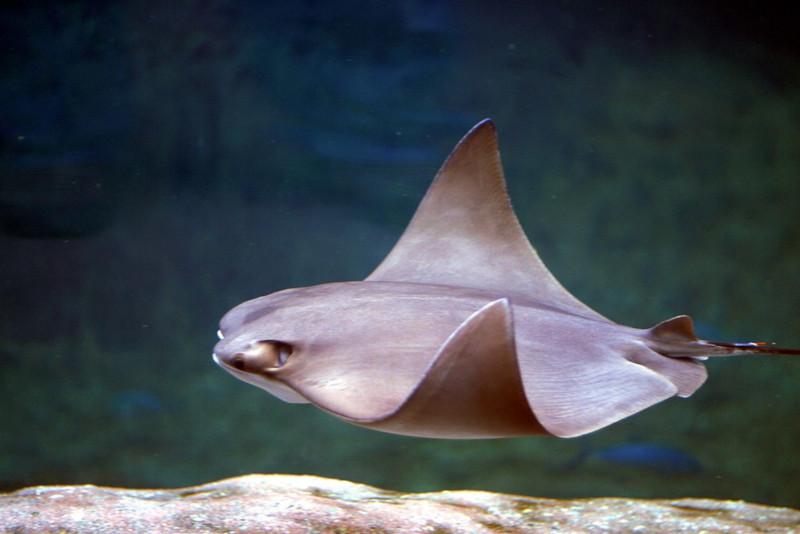Cownose Ray Facts
- The highly distinctive term Cownose Ray serves as the most frequently used common name to refer to a single species of ray found within the genus Rhinoptera. For the moment, however, science recognizes that at least one subspecies of the animal also appears to exist.
- Quite understandably for those who have encountered one of them, the common name for the impressive creature derives from its unique physical appearance. Moreover, this truly remarkable creature technically currently classifies as a variety of what’s known as a stingray.
- This scientific classification occurs due to the extremely close genetic relationship the animal holds with both skates and sharks. In point of fact, this impressive animal, as well as the aforementioned sharks and skates, all belong to the same fascinating Order; Myliobatiformes.
- This beautiful product of Nature and evolution previously appeared to exist in comparatively vast numbers, as well as living across a relatively wide range of distribution. Sadly, however, its estimated population now represents only a very tiny fraction of those past numbers.
- For that reason, among others, the IUCN currently lists this incredible animal as Near Threatened on its published Red List of Threatened Species. The remarkable marine marvel does presently face several ongoing threats to its continued existence as a species at this time.
- While not commercially fished, the amazing fish does frequently fall prey to the actions of recreational fishermen. It also indirectly suffers from a reduction in its food supply, as pollution has now reduced this. Its greatest threat now comes in the form of climate change.
Related Articles
Cownose Ray Physical Description
Perhaps most notably, the beautiful Cownose Ray impresses those who encounter it for reasons other than sheer size. That’s because it ranks as one of the smaller known types of ray found throughout the world. This fact in no way detracts from the awesomeness of the creature, though
In addition to being smaller than many related species on earth, the animal also displays a fairly moderate degree of sexual dimorphism. In its case, though, this natural principle manifests itself in regards to sheer physical size. That’s because males of the species develop as larger than females.
Males of the amazing species attain an average width equaling about 45 in (1. 14 m). These also reach a typical weight of around 50 lb (23 kg). Yet, exceptional specimens occasionally occur. Females, meanwhile, reach a slightly smaller average width, as commonly occurs in species of this type.
In the case of this fascinating animal, this measurement equals approximately 39 in (1 m). The average weight of mature females also typically reaches a total of around 36 lb (16 kg). Unlike in size, specimens of the Cownose Ray of both genders display the same basic overall color pattern.
This distinctive pattern of coloration usually consists of a light to dark brown on the upper side of the body of the wonder. But, the underside of the body of the animal most often displays either a whitish or yellowish color. it also has a barbed tail, and mildly venomous teeth on its spine.
- Kingdom: Animalia
- Phylum: Chordata
- Class: Chondrichthyes
- Order: Myliobatiformes
- Family: Rhinopteridae
- Genus: Rhinoptera
- Species: R. bonasus
Cownose Ray Distribution, Habitat, and Ecology
Thankfully, both for it and those who appreciate Nature, the wonderful Cownose Ray currently inhabits a comparatively broad range of the marine regions of the world. More specifically, though, that territory includes portions of the eastern and western Atlantic Ocean and the Caribbean.
Consequently, this creature may be seen from the coastal waters of New England, in the United States, in North America, to Brazil, in South America. This fascinating animal also distinguishes itself from many of its numerous brethren in terms of its preferences for type of habitat.
That’s due to the fact that the majority of individuals of this species typically appear in areas comprised of shallow, brackish water. This most commonly happens to be where a river empties into the ocean. This wonder of evolution also rarely appears at depths greater than 72 ft (22 m).
The Cownose Ray further remains somewhat famous for its comparatively extensive migrations within its endemic range. Astonishingly, the amazing species also tends to migrate and live in incredible numbers. These massive groupings sometimes number as many as 10,000 individuals.
This pattern of group behavior also remains uncommon among creatures of its type, making it difficult to imagine one of these astounding herds during its migration. Although it differs from its relatives across the globe in some ways, its dietary practices remains consistent with related species.
That’s because this carnivore principally feeds on invertebrates. This diet typically consists of a variety of clams and oysters. Breeding occurs between the months of June and October. The young are born alive, following an 11-12 month gestation period. It also has an average lifespan of 16 years.
Species Sharing Its Range
Check out our other articles on 5 Fabulous European Mammals, Little Penguin, Loktak Lake, Boxfish, Giant Hogweed, Giant Huntsman Spider, Olive Ridley Sea Turtle, Japanese Hare, Purple Frog

